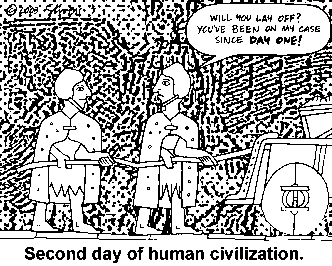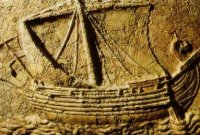COURSE OUTLINE
| Instructor: |
Dr.
Ewa Wasilewska |
| Office
hours: |
By
appointment only; please call the Department of Anthropology (581-6251)
and leave your name, phone number, and class number. Email: Mruczek@AOL.com |
| Time: |
Each
Wednesday at 6:00 p.m. to 9:00 p.m. |
| Location: |
CAMPUS
- ST 208 |
| Important
dates: |
September 3, 2008 - last day to drop classes
September
8, 2008 - last day to register, to elect CR/NC option or to audit classes
October 24, 2008 - last day to withdraw from term length classes |
| Required
Texts: |
All
required articles/chapters (in chronological order) are to be found at
the Reserve Desk at Marriott Library. Please check also electronic reserve
by Marriott Library.
All
articles/chapters are listed below as the required reading for specific
weeks.
|
| Future/Optional
Texts: |
Such
texts are listed after required readings about any of the discussed civilizations.
You don’t have to read them this semester (or any other semester) but if
you are interested in exploring any specific subject on your own, this
is a start. |
| Subject: |
This
course fulfills Social/Behavioral Science Integration. It focuses on the
rise of various civilizations around the world. This class explores such
famous complex societies as Egypt and Mesopotamia, the Maya, as well as
those less known but equally important as the Indus Valley or nomadic empire
of the Hsiung-Nu. |
| Requirements: |
Come
to the lectures, enjoy them, do your readings, and pass required exams!
At the end of the semester turn in your paper (7 pages plus bibliography)
on your most favorite civilization! And remember, always laugh at
the instructor’s jokes! |
..
..
Week
# 1 - August 27, 2008
Toward
a definition of “CIVILIZATION”. PART 1.
[From]
Common understanding: “You know it when you find it,” i.e., selected histories
of discoveries.
-
Origin
of the term itself (Latin “civilis, civilitas, civis, civitas; ”French
“civilisation, civilisateur, civiliser;”).
-
Other
terms (e.g., “prehistory versus history,” “complex versus primitive societies”).
-
Selected
discoveries: Mesopotamia, Egypt, Minoan, and Mesoamerican civilizations.
|
...... |
 |
Required
reading:
Chazan, Michael: Putting the Picture Together. Pp. 37-59. In World Prehistory and Archaeology: Pathways through Time. Pearson Education. 2008.
Week
# 2 - September 3, 2008
Toward
a definition of “CIVILIZATION”. PART 2.
[Through]
Classical listing of elements of civilization (understood as “urbanization”).
Required
readings:
Childe,
V. Gordon. The Urban Revolution. Pp. 6-14. In Lamberg-Karlovsky,
C.C. & Jeremy A. Sabloff. The Rise And Fall of Civilizations. Cummings
Publishing Company. 1974.
[To]
Modern methodologies in comparative studies of various civilizations.
Buren,
Mary Van & Janet Richards. Introduction: ideology, wealth, and the
comparative study of “civilizations.” Pp. 3-12. In Order,
Legitimacy, and Wealth in Ancient States. Part I: Order, Legitimacy, and
Wealth in Ancient States. Cambridge University Press. 2000.
Baines,
John & Norman Yoffee. Order, legitimacy, & wealth: setting the
terms. Pp. 13-17. In Buren, Mary Van & Janet Richards, eds.
Order, Legitimacy, and Wealth in Ancient States. Part I: Order, Legitimacy,
and Wealth in Ancient States. Cambridge University Press. 2000.
Future/optional
reading:
McGuire,
Randall H. Core and Periphery Systems. Pp. 132-137. In Ellis, Linda
ed. Archaeological Method and Theory. An Encyclopedia. Garland Publishing,
Inc. 2000. |
..... |
 |
Week
# 3 - September 10, 2008
Civilization
out of clay: MESOPOTAMIA.
-
Writing:
the main or just contributing factor in the development of civilization.
-
Temples
- centers of distribution.
-
Many
“firsts” on which a civilization is supposed to be based.
-
From
city-states to the first empire.
-
Rich
people, “poor” neighbours.
-
Childe’s
and others’ check lists.
|
...... |
 |
Required
readings:
Chazan, Michael: Mesopotamia. Pp. 323-334.
In World Prehistory and Archaeology: Pathways through Time. Pearson Education. 2008.
Cooper, Jerrold S.: Babylonian Beginnings: The Origin of the Cuneiform Writing System In Comparative Persepctive. Pp. 71-99. In Houston, Stephen G. ed. The First Writing: Script Invention and Process. Cambridge University Press. 2004.
Future/optional
reading (absolutely great and fun to read):
Kramer,
Samuel Noah. History Begins in Sumer. The University of Pennsylvania
Press. 1981.
Movies:
Iraq:
The Cradle of Civilization. Legacy . #1. V-Cass CB 311 L43 1991.
Mesopotamia. I Have Conquered the River. CB 311 M48 2003 v. 2.
Week
# 4 - September 17, 2008
Cities
of the dead but where were the living? EGYPT.
.
-
Religion:
through battles to unity.
-
Pharaoh:
a god left behind?
-
Writing:
an independent invention?
-
Grand
scale of public works.
-
Urban
legend of the huts.
-
Childe’s
and others’ check lists.
|
...... |
|
Required
readings:
Redford,
Donald B. The Ancient Egyptian “City”: Figment or Reality? Pp. 210-220.
In Aufrecht, Walter E., Neil A. Mirau & Steven W. Gauley eds. Urbanism
in Antiquity. Sheffield Academic Press. 1997.
Routledge,
Carolyn. Temple as the Center in Ancient Egyptian Urbanism. Pp. 221-235.
In Aufrecht, Walter E., Neil A. Mirau & Steven W. Gauley eds. Urbanism
in Antiquity. Sheffield Academic Press. 1997.
Chazan, Michael: Egypt. Pp. 360-375. In World Prehistory and Archaeology: Pathways through Time. Pearson Education. 2008.
Future/optional
readings (fun, fun, fun):
Almost
anything about ancient Egyptian religion. (Avoid those without pictures).
Karl-Theodor
Zauzich: Hieroglyphs without Mystery. University of Texas Press. 1996.
(Impress your friends with knowledge of the ancient Egyptian script).
Movies:
Egypt:
Quest for Immortality. Time Life’s Lost Civilizations. #4. V-Cass CB 311
T54 1995 v. 1.
Egypt: Journey to the Global Civilization. CB 311 M48 2003 v. 1.
Week
# 5 - September 24, 2008
Summary with movies.
Review.
Week
# 6 - October 1, 2008
 #1 #1
Week
# 7 - October 8, 2008
The
greatest bazaars (markets) in the world. CANAAN/PHOENICIA.
-
It
is all about neighborhood: trading competition.
-
The
sea knows no limit: spreading "the word".
-
The
price of peace: let foreign empires set up their rules.
-
A case
of “megalomania”: ancient Israel according to the Old Testamental authors.
-
Childe’s
and others’ check lists.
|
...... |
|
Required
readings:
Patterson,
Thomas C. State Formation, Ethnogenesis, and Resistance: The Levant in
the First Millennium B.C. Pp. 216-226. In Archaeology. The Historical
Development of Civilizations. Prentice Hall. 1993.
Gore, Rick: Who Were the Phoenicians? Pp.26.49. In National Geographic. October 2004.
Future/optional
readings:
Markoe,
Glenn E. Peoples of the Past: Phoenicians. University
of California Press.
For
information about sailing the Atlantic see Cunliffe, Barry. Facing the
Ocean. The Atlantic and Its People. Oxford University Press. 2001.
Week
# 8 - October 15, 2008
FALL BREAK!
Week
# 9 - October 22, 2008
Staying
in charge. The emergence of THE MINOAN
and
MYCENAEAN civilizations...
-
Palace-centered
polities.
-
Mystery
of its origin – the Minoan Linear A.
-
Continuation
of the island culture on land: the Mycenaean civilization.
-
Heinrich
Schliemann: reinventing the legend of Troy.
-
Childe’s
and others’ check lists.
|
...... |
|
Required
readings:
Tsipopoulou,
Metaxia. Palace-Centered Polities in Eastern Crete: Neopalatial Petras
and Its Neighbors. Pp. 263-277. In Aufrecht, Walter E., Neil A.
Mirau & Steven W. Gauley eds. Urbanism in Antiquity. Sheffield
Academic Press. 1997.
Wolff,
Walther. The Aegean. Pp. 165-203. In Early Civilizations: Egypt,
Mesopotamia, the Aegean. The Herbert Press. 1989.
Check also: www.ou.edu/finearts/art/ahi4913/aegean.html and www.daedalus.gr/DAEI/THEME/Knossos.htm
Future/optional
readings:
Works
of Homer. You should go through them at least once in your life.
Movie:
Aegean:
Legacy of Atlantis. Time Life’s Lost Civilizations. #4. V-Cass CB 311 T54
1995. 48 minutes.
Week
# 10 - October 29, 2008
Galloping
through the steppe to civilization.
THE
HITTITES and others OF ANATOLIA.
-
Çatal
Hüyük - a city with no right to exist.
-
The
Indo-Europeans and those whom they ruled.
-
From
nomads to urban dwellers to an empire?
-
In
the name of tolerance: let’s worship them all.
-
Childe’s
and others’ check lists.
|
...... |
|
Required
readings:
Dunstan,
William E. Chapter VIII. The Hittites of Anatolia and Their Contemporaries.
Pp. 154-175. In The Ancient Near East. Harcourt Brace College
Publishers. 1998.
Check also: www.allaboutturkey.com/hitit.htm
Balter, Michael: The First Cities: Why Settle Down? The Mystery of Communities. In Science 20, November 1998: Vol. 282.no.5393, p. 1442 (www.sciencemag.org/cgi/content/full/282/5393/1442).
For more general information about Çatal Hüyük check also: http://wcuww.com/civcty/cathyk00.htm
For scientific reports check: www.catahoyuk.com
Future/optional
reading:
Macqueen,
J.G. The Hittites and Their Contemporaries in Asia Minor. Thames and
Hudson. 1986.
Balter, Michael. Çatal Hüyük: An Archaeological Journey to the Dawn of Civilization. Free Press. 2005.
Week
# 11 - November 5, 2008
Divine
authority and divided reality of the empire. PERSIA.
-
The
forgotten civilization: Elam.
-
Arrival
of the "Aryans" and their dominance in the area (The Medes and the Persians).
-
Too
nice to last? The empire of tolerance and moderation.
-
Between
monotheism and polytheism: divine authority of Zaratushtra.
-
Childe’s
and others’ check lists.
|
...... |
|
Required
reading:
Dunstan,
William E. Chapter XIII and XIV. Persia. Persian Cultural Achievements.
Pp. 267-294. In The Ancient Near East. Harcourt Brace College
Publishers. 1998.
Check also: www.museum-achemenet.college-de-france.fr and www.iranchamber.com/history/elamite/elamite.php on Elam
Future/optional
reading (somewhat dry but quite informative):
Curtis,
John. Ancient Persia. Harvard University Press. 1990.
Movie:
To
be decided.
Week
# 12 - November 12, 2008
 #2 #2
Week
# 13 - November
19, 2008
Land
without conflict? THE INDUS VALLEY civilization.
-
The
Dravidian and Indo-Aryan question.
-
Land
without social stratification?
-
Too
much religion or not enough - can we even speculate?
-
Focus
on hygiene? Disposable cups and bath-houses.
-
Childe’s
and others’ check lists.
|
...... |
|
Required
readings:
Patterson,
Thomas C. Harappan Society: Class-stratified or kin-based? Pp. 141-146.
In Archaeology. The Historical Development of Civilizations. Prentice
Hall. 1993.
Chazan, Michael: The Indus Valley. Pp. 375-380. In World Prehistory and Archaeology: Pathways through Time. Pearson Education. 2008.
Check also: www.harappa.com/har/har0.html
Future/optional
reading (very informative):
Kenoyer,
Jonathan Mark. Ancient Cities of the Indus Valley Civilization. Oxford
University Press. 1998.
Movie:
India: The Unvoiced Civilization. CB 311 M48 2003 v. 3
Week
# 14 - November
26, 2008
Too
many empires, too much conflict: CHINA AND HSIUNG-NU.
PART
1.
-
Sedentary
versus nomadic empires: China vs. Hsiung-Nu.
-
The
Great Wall and Teracotta Warriors of Xi’an.
-
In
search of defense: the Silk Road.
-
Is
the conflict still there?
-
Childe’s
and others’ check lists.
|
...... |
|
Required
readings:
Barnes,
Gina L. Chapter 12. The Making and Breaking of Empire. 220 B.C. - A.D.
500. Pp. 192-207. In The Rise of Civilization in East Asia: The
Archaeology of China, Korea and Japan. Thames & Hudson. 1999.
Di
Cosmo, Nicola. Those Who Draw the Bow. The Rise of the Hsiung-nu Nomadic
Empire and the Political Unification of the Nomads. Pp. 161-205. In
Ancient
China and Its Enemies. The Rise of Nomadic Power in East Asian History.Cambridge
University Press. 2002.
Chazan, Michael: Shang China. Pp. 350-355. In World Prehistory and Archaeology: Pathways through Time. Pearson Education. 2008.
Check also: www.ess.uci.edu/~oliver/silk.html and www.chinaknowledge.de/History/Myth/shang.html
Future/optional
reading (very interesting but also confusing at times):
Di
Cosmo’s whole book.
Movies:
China:Heritage of the Wild Dragon. CB 311 M48 2003 v. 4
China:
The Mandate of Heaven. Legacy . #3. V-Cass CB 311 L43 1991.
Silk
Road series.
Week
# 15 - December 3, 2008
Too
many empires, too much conflict: CHINA AND HSIUNG-NU.
PART
2.
Week
# 16 - December 10, 2008
The
"enigma" of the New World: THE MAYA,
THE
AZTECS and THE INCAS.
-
Continuum
of complexity: Mesoamerica as a scholarly dream.
-
From
prehistory to history: decipherment of the Mayan languages and writing.
-
Chocolate
to die for: human sacrifices and commerce among the Aztecs.
-
Is
the writing necessary? The Inca Empire.
-
Childe’s
and others’ check lists.
|
...... |
|
Required
readings:
Smith,
Michael E. & Marilyn A. Masson, eds. Part III. Political Organization.
(6 articles by different authors). Pp. 252-359. In The Ancient Civilizations
of Mesoamerica. A Reader. Blackwell Publishers. 2000.
Chazan, Michael: The Maya. Pp. 334-350. The Inca Empire. The Aztec Empire. Pp. 388-413. In World Prehistory and Archaeology: Pathways through Time. Pearson Education. 2008.
Future/optional
reading (fun and informative):
Foster,
Lynn V. Handbook to Life in the Ancient Maya World. Facts On File,
Inc. 2002.
Movies:
Inca:
Secrets of the Ancestors. Time Life’s Lost Civilizations. #9. V-Cass CB
311 T54 1995. v. 9.
Maya:
The Blood of Kings. Time Life’s Lost Civilizations. #9. V-Cass CB 311 T54
1995. v. 2. 48.
Week
# 17 - December 17, 2008
FINAL 
Last day to turn in your
papers.
 IMPORTANT!!! IMPORTANT!!!
ACADEMIC MISCONDUCT
Please familiarize yourself with the University of Utah CODE OF STUDENT RIGHTS AND RESPONSIBILITIES (“STUDENT CODE”) at www.admin.utah.edu/ppmanual//8/8-10.html
The following is an excerpt from this CODE explaining specific actions, which won’t be tolerated in this class.
“2. “Academic misconduct” includes, but is not limited to, cheating, misrepresenting one's work, inappropriately collaborating, plagiarism, and fabrication or falsification of information, as defined further below. It also includes facilitating academic misconduct by intentionally helping or attempting to help another to commit an act of academic misconduct.
a. “Cheating” involves the unauthorized possession or use of information, materials, notes, study aids, or other devices in any academic exercise, or the unauthorized communication with another person during such an exercise. Common examples of cheating include, but are not limited to, copying from another student's examination, submitting work for an in-class exam that has been prepared in advance, violating rules governing the administration of exams, having another person take an exam, altering one's work after the work has been returned and before resubmitting it, or violating any rules relating to academic conduct of a course or program.
b. Misrepresenting one's work includes, but is not limited to, representing material prepared by another as one's own work, or submitting the same work in more than one course without prior permission of both faculty members.
c. “Plagiarism” means the intentional unacknowledged use or incorporation of any other person's work in, or as a basis for, one's own work offered for academic consideration or credit or for public presentation. Plagiarism includes, but is not limited to, representing as one's own, without attribution, any other individual’s words, phrasing, ideas, sequence of ideas, information or any other mode or content of expression.
d. “Fabrication” or “falsification” includes reporting experiments or measurements or statistical analyses never performed; manipulating or altering data or other manifestations of research to achieve a desired result; falsifying or misrepresenting background information, credentials or other academically relevant information; or selective reporting, including the deliberate suppression of conflicting or unwanted data. It does not include honest error or honest differences in interpretations or judgments of data and/or results.”
The following sanctions will be imposed in this class for a student engaging in academic misconduct:
1. A failing grade for the specific assignment, paper, exam, etc., without possibility to re-write it, re-take it, etc. This academic misconduct will be reported to the Chairman of the Department of Anthropology.
2. The second offense will be sanctioned with a failing grade for the whole course. In such a case, the following rule of the University of Utah CODE OF STUDENT RIGHTS AND RESPONSIBILITIES is applicable and will be followed: “If the faculty member imposes the sanction of a failing grade for the course, the faculty member shall, within ten (10) business days of imposing the sanction, notify in writing, the chair of the student’s home department and the senior vice president for academic affairs or senior vice president for health sciences, as appropriate, of the academic misconduct and the circumstances which the faculty member believes support the imposition of a failing grade.”
3. For more information concerning sanctions for academic misconduct (additional sanctions might be imposed) and your rights and procedures to appeal these sanctions please refer to the aforementioned CODE.
If you need more information and/or explanations please don’t hesitate to contact the instructor.
Ewa
Wasilewska's Home Page |













 IMPORTANT!!!
IMPORTANT!!!